Related Research Articles
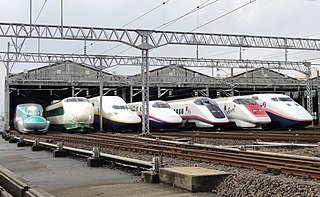
The Shinkansen, colloquially known in English as the bullet train, is a network of high-speed railway lines in Japan. Initially, it was built to connect distant Japanese regions with Tokyo, the capital, to aid economic growth and development. Beyond long-distance travel, some sections around the largest metropolitan areas are used as a commuter rail network. It is owned by the Japan Railway Construction, Transport and Technology Agency and operated by five Japan Railways Group companies.
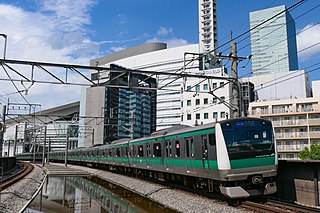
The Saikyō Line is a Japanese railway line operated by the East Japan Railway Company. It connects Ōsaki Station in Shinagawa, Tokyo, and Ōmiya Station in Saitama Prefecture. The line's name is a portmanteau of the two areas the line connects: Saitama and Tōkyō.

Hachinohe Station is a railway station operated by the East Japan Railway Company in Hachinohe, Aomori, Japan.
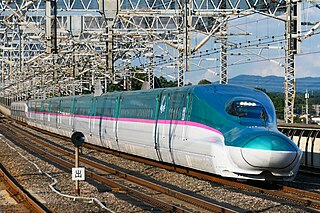
The Tōhoku Shinkansen (東北新幹線) is a Japanese high-speed Shinkansen rail line, connecting Tokyo with Aomori in Aomori Prefecture in a route length of 674.9 km (419.4 mi), making it Japan's longest Shinkansen line. It runs through the more sparsely populated Tōhoku region of Japan's main island, Honshu, and was extended as the Hokkaido Shinkansen through the Seikan Tunnel to Shin-Hakodate-Hokuto and is expected to be extended to Sapporo by 2030. It has two Mini-shinkansen branch lines, the Yamagata Shinkansen and Akita Shinkansen. The line is operated by East Japan Railway Company.
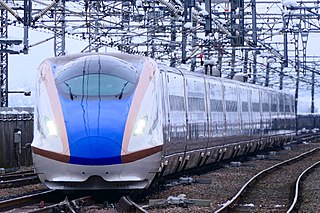
The Jōetsu Shinkansen (上越新幹線) is a high-speed shinkansen railway line connecting Tokyo and Niigata, Japan, via the Tōhoku Shinkansen, operated by the East Japan Railway Company. Despite its name, the line does not pass through the city of Jōetsu or the historical Jōetsu region, which instead are served by the Hokuriku Shinkansen. The name instead originates from the parallel Jōetsu Line, which in turn is named after the two provinces that it connects: Jōshū, and Echigo Province.

The Tobu Tojo Line is a 75.0 km (46.6 mi) suburban railway line in Japan which runs from Ikebukuro Station in Toshima, Tokyo to Yorii Station in Yorii, Saitama, operated by the private railway operator Tobu Railway. Its official name is the Tobu Tojo Main Line, but it is referred to as Tobu Tojo Line on Tobu signage and publicity information.

Automatic train control (ATC) is a general class of train protection systems for railways that involves a speed control mechanism in response to external inputs. For example, a system could effect an emergency brake application if the driver does not react to a signal at danger. ATC systems tend to integrate various cab signalling technologies and they use more granular deceleration patterns in lieu of the rigid stops encountered with the older automatic train stop (ATS) technology. ATC can also be used with automatic train operation (ATO) and is usually considered to be the safety-critical part of a railway system.
![<span class="mw-page-title-main">Rail transport in Japan</span> Rail transport in Japan[Nippon] -Japanese Railways](https://upload.wikimedia.org/wikipedia/commons/thumb/0/0f/Railway_Route_Map_of_Japan.png/320px-Railway_Route_Map_of_Japan.png)
Rail transport in Japan is a major means of passenger transport, especially for mass and high-speed travel between major cities and for commuter transport in urban areas. It is used relatively little for freight transport, accounting for just 0.84% of goods movement. The privatised network is highly efficient, requiring few subsidies and running with extreme punctuality, though since privatisation several unprofitable but socially valuable lines have been closed by private operators.
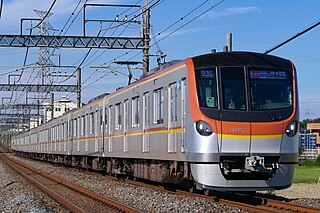
The Tokyo Metro Fukutoshin Line, formally the No. 13 Fukutoshin Line, is a 20.2-kilometer (12.6 mi) subway line operated by Tokyo Metro in west-central Tokyo and Wako, Saitama, Japan. The newest line in the Tokyo subway network, it opened in stages between 1994 and 2008. On average, the Fukutoshin Line carried 362,654 passengers daily in 2017, the lowest of all Tokyo Metro lines and roughly one third of its sister Tokyo Metro Yūrakuchō Line (1,124,478).

The Seibu Shinjuku Line is a Japanese railway line owned by the private railway operator Seibu Railway, connecting Seibu Shinjuku Station in Shinjuku, Tokyo with Hon-Kawagoe Station in Kawagoe, Saitama.

The transport network in Greater Tokyo includes public and private rail and highway networks; airports for international, domestic, and general aviation; buses; motorcycle delivery services, walking, bicycling, and commercial shipping. While the nexus is in the central part of Tokyo, every part of the Greater Tokyo Area has rail or road transport services. There are also a number of ports offering sea and air transport to the general public.

Yonohommachi Station is a passenger railway station on the Saikyō Line located in Chūō-ku, Saitama, Saitama Prefecture, Japan, operated by the East Japan Railway Company.

Minami-Yono Station is a passenger railway station on the Saikyō Line located in Chūō-ku, Saitama, Saitama Prefecture, Japan, operated by the East Japan Railway Company.
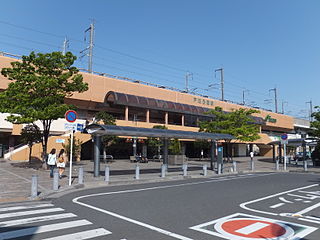
Toda-kōen Station is a passenger railway station located in the city of Toda, Saitama, Japan, operated by the East Japan Railway Company.

Station numbering is a sign system which assigns station codes consisting of a few letters and numbers to train stations. It aims to facilitate navigation for foreign travelers not familiar with the local language by using globally understood characters. The system is now in use by various railway companies around the world such as in Mainland China, Indonesia, Japan, South Korea, Singapore, Taiwan, Thailand, and the United States.
References
- (June 1995), "Timeline", Trains Magazine, p. 19.
- ↑ Alaska Railroad. "History". Archived from the original on 5 January 2007. Retrieved 2007-01-03.
- ↑ "会社情報" [About us]. kitakyushu-monorail.co.jp (in Japanese). Archived from the original on 27 July 2023. Retrieved 8 February 2024.
- ↑ 日本国有鉄道停車場一覧[JNR Station Directory]. Japan: Japanese National Railways. 1985. p. 31. ISBN 4-533-00503-9.
- ↑ Berkowitz, Eric (August 18, 2005). "The Subway Mayor". LA Weekly . Archived from the original on August 30, 2008. Retrieved 2010-10-11.
- ↑ Belcher, Jonathan. "Changes to Transit Service in the MBTA district" (PDF). Boston Street Railway Association.
- ↑ "Significant dates in Canadian railway history". Colin Churcher's Railway Pages. 2006-03-17. Archived from the original on 27 April 2006. Retrieved 2006-04-26.
- ↑ Sloan, Jim (January 3, 1999). "It's the end of the line". The Tampa Tribune. p. Metro 1.
- ↑ Balkwill, Richard; Marshall, John (1993). The Guinness Book of Railway Facts and Feats (6th ed.). Enfield: Guinness Publishing. ISBN 0-85112-707-X.
- 1 2 "개요 및 연혁" [Overview and History]. seoulmetro.co.kr (in Korean). Archived from the original on 5 February 2024. Retrieved 12 July 2024.